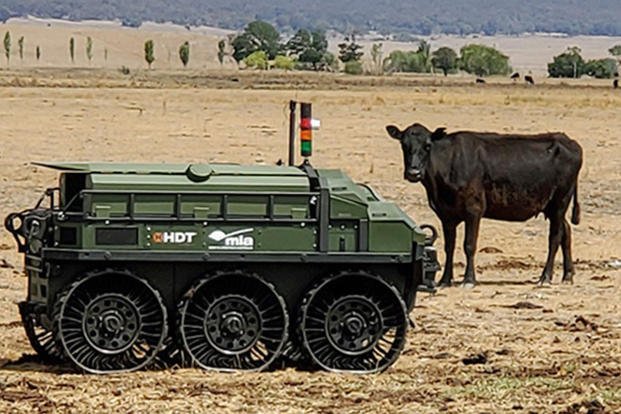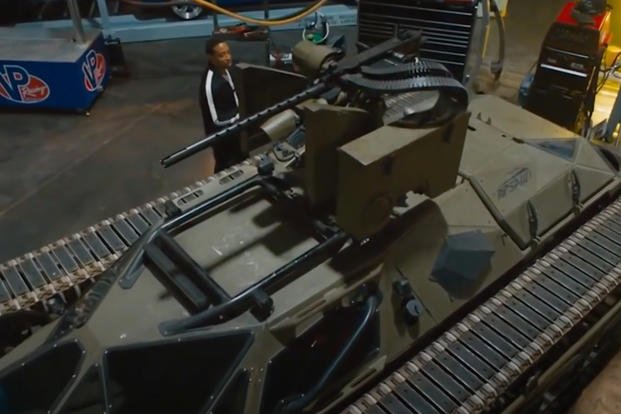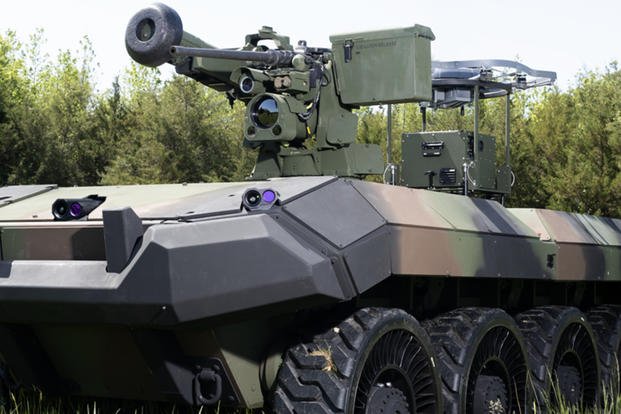Why should the air-side service members have all the fun? For decades, they’ve taken to the skies with remotely operated aircraft that can spot the enemy through pitch darkness from thousands of feet above and deliver pinpoint strikes without breaking a sweat.
Finally, the Army is looking for a Robotic Combat Vehicle that can take the fight to the enemy on the ground. It’s an ambitious but worthwhile project. When it’s done, soldiers will have access to unmanned armored vehicles that can drive silently alongside them, scout for danger ahead and unleash a world of hurt on the enemy.
One of the vehicles in contention is the brainchild of not one but three collaborative defense companies: BAE Systems, HDT Global and McQ Inc. It’s called the WOLF-X, and this is everything we know so far.
Meet the Dream Team Behind the WOLF-X
According to a McQ release, the Army selected the Fredericksburg, Virginia, company as one of four primary contractors to participate in Phase I prototyping as part of its RCV program. McQ specializes in surveillance and communications equipment for military, defense and law enforcement customers. Beyond that, the company keeps a pretty low profile.
Weapon systems will come from BAE Systems. The defense industry giant’s ground systems currently include the Bradley Fighting Vehicle and Amphibious Assault Vehicle. Other products include autonomous aircraft, electronic warfare technology and munitions ranging from 5.56 NATO ammunition to the Spearfish heavyweight torpedo.
HDT builds the robotic vehicle that brings all these forces to bear. The predecessor to the WOLF-X is the Wolf — a platform that’s roughly the size of an ATV but far more capable. Civilian variants perform heavy lifting for farmers, ranchers and firefighters. HDT builds a militarized version to haul cargo and take other dangerous work off soldiers’ plates.
Welcome to the Pack, WOLF-X

The WOLF-X is a prototype, but the platform has been in production for a while. According to HDT, most are more like soldiers’ friendly helpers rather than remotely operated tanks. There are variants for carrying cargo, evacuating casualties, clearing mines and generating power. There’s even one that can deploy an inflatable bridge capable of spanning 36-foot gaps.
The WOLF-X, on the other hand, is built to go on the offensive. Sensors from McQ and weapons from BAE suggest it will have a powerful — and precise — punch.

Underneath the guided missiles and chain guns, HDT specs out the WOLF-X with eight wheels instead of six, each with more than a foot of independent suspension travel. Airless tires mean the WOLF-X will never get a flat.
The hybrid diesel-electric powertrain produces enough power to conquer all kinds of terrain and operate silently to avoid detection. The liquid-cooled, lithium-iron-phosphate battery is rated for a wide range of operating conditions.
HDT is tight-lipped about the WOLF-X’s capabilities while testing is underway, but we can assume it’s a significant step up from its smaller litter-mate, the Hunter Wolf, which is capable of carrying a 2,200-pound payload 200 miles, using only its internal diesel to recharge the electric battery.
“The HDT WOLF-X exceeds all RCV requirements with an advanced design that is engineered for future growth,” Tom Van Doren, HDT Global chief technical officer, said. “Leveraging our expertise in robotic vehicle design and manufacturing, the WOLF-X expands on the mature technology of the HDT robotic Hunter Wolf, delivering the right material solution to carry out critical missions on the complex modern battlefield.”
While a lot of questions remain unanswered, it looks as though the WOLF-X would be an intelligent, maneuverable force to reckon with on the battlefield.
There Are Other Predators in These Woods

This is just the beginning of the Army’s RCV search. According to an Army release, four companies are competing for the contract in Phase I testing.
General Dynamics Land Systems (of M1A1 fame) submitted the TRX, a tracked 10-ton robotic vehicle that the company hopes will be able to meet a wide range of mission requirements with customizable weapon systems and attachments.
Oshkosh Defense has barely said a word about its RCV prototype, but the people who brought us the MTVR, HEMTT and JLTV certainly know what they’re doing.
Last but not least, Textron Systems appears to be bringing the Ripsaw off the silver screen and onto the battlefield. Unlike the one we saw in “The Fate of the Furious,” this one won’t have Ludacris (or anyone else, for that matter) behind the wheel.
Robotic Combat Is the Future
Unmanned combat aircraft are nothing new. In addition to high-tech MQ-1B Predator drones, homemade alternatives are popping up across Ukraine and the Middle East. It was only a matter of time before robotics played a significant role in ground warfare, too.
Still, red-blooded American door-kickers with rifles aren’t going away anytime soon. According to a report from the Congressional Research Service, the Army plans to use whichever vehicle wins the middleweight RCV-M contract in an escort or scouting role.
When paired with tanks and other armored fighting vehicles, it will provide flank security and route clearance without putting service members at risk. Since it will be relatively small and quiet, the RCV will also be a huge asset to ground troops.
We still don’t know what the first-generation RCV will look like — the Army plans to select a winner in the spring of 2025, according to Defense News — but I’m glad we’ll find out from the friendly end of its wrath.
Want to Know More About the Military?
Be sure to get the latest news about the U.S. military, as well as critical info about how to join and all the benefits of service. Subscribe to Military.com and receive customized updates delivered straight to your inbox.
Story Continues
Read the full article here

